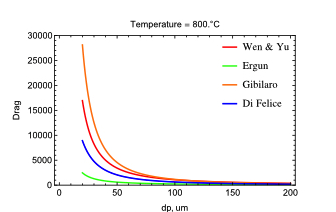
Background
The drag force is the friction that a fluid imposes on an object, and the friction the object imposes on the fluid. They are equal but opposite forces. This two-way coupling of the drag force can best be demonstrated by driving with your hand outside the window. You can feel the force on your hand. However, your hand is causing the air flow to be disturbed as well.
In a fluidized bed, it is the drag force that counteracts the force of gravity which results in the bed being fully suspended. At high superficial gas velocities, particles become entrained and leave the bed. For a single particle, the determination of the drag force is straightforward, and is typically described by the kinetic energy times the cross sectional area times a drag coefficient .
However, for particles in a fluidized bed, particles are affected by more than just a single drag force. Collisional stresses can change the direction and rotation of a particle. Particles, especially small particles, can cluster which results in a larger aerodynamic drag. A particle in front of another particle can reduce the drag on the following particle due to a fluid velocity reduction from the hydrodynamic shedding of the advancing particles.
Thus, using a single particle drag force relationship does not make sense for application in a fluidized bed. Yet, that is often what is used. Similarly, using a drag force from a packed bed also does not make sense since particle motion affects the drag force on the surrounding particles. Corrections to these drag models are available, but these corrections are empirically based.
Until recently, little attention has been focused on particle drag for the simulation of fluidized bed hydrodynamics. As a result, the commonly used drag force models used for modeling tend to over predict the entrainment rate and under predict the bed expansion, especially for Geldart Group A and C particles.
In an effort to provide better validation of simulation results for fluidized bed models, PSRI is proposing a drag model development and application program. Research efforts will include a fundamental look at particle properties and how such properties affect clustering and drag with the objective of developing or implementing a model for CFD applications using a variety of academic or commercial codes.
This PSRI Program has the following objectives
- Provide minimum fluidization and bubbling velocities, and bed densities for 15 materials ranging from FCC powder of different fines levels to large polycrystalline silicon particles,
- Perform CFD simulations of the minimum fluidization experiment for selected materials with emphasis on various drag models,
- Perform parametric study on grid and particle parcel resolutions,
- Perform parametric study on bubble hydrodynamics with and without baffles for selected materials,
- Develop and automated particle settling test unit,
- Provide settling velocity data and terminal velocity calculations based on the automated particle settling test unit,
- Provide high speed movies of particle and cluster hydrodynamics for selected materials,
- Obtain data on bed density, bubble volume and volume distributions, bubble size and rise velocity, degree of clustering and cluster size in the bed and freeboard, and entrainment rates from a 2D fluidized bed,
- Obtain data on bed density, bubble volume and volume distributions from capacitance tomography (CT), bubble size and rise velocity, degree of clustering and cluster size in the bed and freeboard, and entrainment rates from a 3D fluidized bed,
- Obtain data on bed density, minimum fluidization velocity, minimum bubble velocity, and entrainment rates from a high-temperature fluidized bed,
- Obtain data on bed density, minimum fluidization velocity, minimum bubble velocity, and entrainment rates from a high-pressure fluidized bed,
- Provide high-speed movies of bubble hydrodynamics in 2D (macro-view) and 3D (micro-view) fluidized beds,
- Perform CFD simulations of 2D, 3D and high-temperature fluidized beds,
- Develop a non-linear statistical model with parametric parameter sensitivity for selected drag models,
- Present a vetted drag model with revised parameters for CFD modeling of fluidized bed systems,
- Revised PSRI entrainment rate correlation for particle clustering based on learnings from this program.
